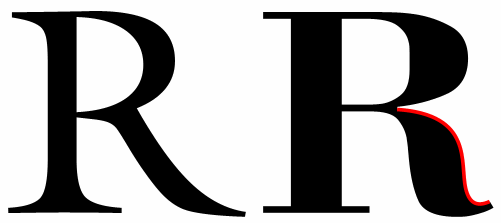Nonlinear Design. Examples II
| Examples II |
|
|

| Fig. 6: Exploring the letterform curves (fonts shown are Gaillard Bold and Bodoni Bold) |
|
The first thing that we notice is that, whatever are the curvature
characteristics of the letters' outlines, all of them show a great
respect for horizontal and vertical guidelines. This is, of course,
natural: a letter always exists in a pronouncedly rectangular coordinate
system, and it cannot disregard the horizontals of text lines and
verticals of text block alignments.
Overall, however, the Humanist letter on the left seems to be much more careless about architectonics. Careful investigation reveals quite a number of slanted parts in the left letter's outline, from the relaxedly lowered tip of R's lower right leg, to a slight bulge on the top outline, to the right of the main vertical stroke. By contrast, the Modern Antiqua can only boast a curly tip of the bottom right stroke, while all others curves obediently flow into horizontal or vertical straight lines. So we see that, in full correspondence with their respective level of humanization, one of these samples lies significantly above the other on the chart, although both letters still remain in its top half. The curvature range comparison is more complicated. At first sight, the Modern Antiqua letter at right seems to be more uneven with regard to curvature, more strained and artificial. Indeed, for example, the outer outline of the letter's lower right leg (marked red on Fig. 6) shows striking variations of curvature, from a smooth wide bend at the top to the small curved tip at bottom. However, if you load a copy of that letter into a drawing program, you'll discover that you cannot successfully approximate all of that curve with one Bezier of varying curvature, but only with two conjugate fragments, each with roughly constant curvature (i.e. each being close to a circular arc). The fact that this part of the outline is not an integral Bezier curve is directly related to the obvious fact that this letter was not designed with freehand strokes, but was carefully constructed from straight lines and circular arcs, with curvature changing abruptly at their conjugation points. We at once feel the rather technical, anti-humanist character of the letter, and the Bezier experiment only confirms our expectations. So, despite the visibly different curvatures of Modern Antiqua outlines, this lettershape should definitely be placed in the left half of our chart. On the other hand, the Old Style letter at the left shows truly smooth curvature variations, which would be unachievable without using Beziers - or without simply drawing the curvilinear parts of the outline by hand, which is of course how the original Antiquas of 16 and 17th centuries were designed. This places humanistic letterforms in the right half of the chart. It's easy to see here how technology defines aesthetics: Early typographers saw no problem with hand-drawn letters, especially since they most often personally controlled the production and use of all copies of their font sets. Later, with book production turning into a large-scale industry, lettershapes had to be simplified so as to be reliably reproducible by technical means - that is, by ruler and compass that we see extensively used in Transitional and especially Modern Antiqua styles. It was only in our century that Bezier curves re-enabled the Renaissance level of expression in fontography and made it possible to adequately recreate the old fonts on computers. |
Revised: Feb. 12, 1999
URL: https://www.webreference.com/dlab/9902/examples-ii.html


 Find a programming school near you
Find a programming school near you